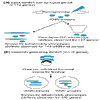High-throughput reverse genetics: RNAi screens in Caenorhabditis elegans
- PMID: 11182891
- PMCID: PMC138903
- DOI: 10.1186/gb-2001-2-2-reviews1005
High-throughput reverse genetics: RNAi screens in Caenorhabditis elegans
Abstract
Two recent chromosome-wide screens for phenotypes caused by RNA-mediated interference (RNAi) in Caenorhabditis elegans have increased our understanding of essential genes in nematodes. These papers represent a major advance in functional genomics.
Figures

Similar articles
-
Functional genomic approaches in C. elegans.Methods Mol Biol. 2006;351:127-38. doi: 10.1385/1-59745-151-7:127. Methods Mol Biol. 2006. PMID: 16988431 Review.
-
New genes with roles in the C. elegans embryo revealed using RNAi of ovary-enriched ORFeome clones.Genome Res. 2005 Feb;15(2):250-9. doi: 10.1101/gr.3194805. Genome Res. 2005. PMID: 15687288 Free PMC article.
-
Genomics: frontiers of gene function.Nature. 2005 Mar 24;434(7032):444-5. doi: 10.1038/434444a. Nature. 2005. PMID: 15791235 No abstract available.
-
Uncover genetic interactions in Caenorhabditis elegans by RNA interference.Biosci Rep. 2005 Oct-Dec;25(5-6):299-307. doi: 10.1007/s10540-005-2892-7. Biosci Rep. 2005. PMID: 16307378 Review.
-
RNAi and double-strand RNA.Genes Dev. 1999 Jan 15;13(2):139-41. Genes Dev. 1999. PMID: 9925636 Review. No abstract available.
Cited by
-
Nematodes feel a craving--using Caenorhabditis elegans as a model to study alcohol addiction.Neurosci Bull. 2014 Aug;30(4):595-600. doi: 10.1007/s12264-014-1451-7. Epub 2014 Jul 9. Neurosci Bull. 2014. PMID: 25008572 Free PMC article. Review.
-
Worm Phenotype Ontology: integrating phenotype data within and beyond the C. elegans community.BMC Bioinformatics. 2011 Jan 24;12:32. doi: 10.1186/1471-2105-12-32. BMC Bioinformatics. 2011. PMID: 21261995 Free PMC article.
-
Transforming petals into sepaloid organs in Arabidopsis and oilseed rape: implementation of the hairpin RNA-mediated gene silencing technology in an organ-specific manner.Planta. 2004 Jan;218(3):379-87. doi: 10.1007/s00425-003-1117-1. Epub 2003 Oct 8. Planta. 2004. PMID: 14534787
-
Recent advances in understanding of the mechanisms of RNA interference in insects.Insect Mol Biol. 2025 Aug;34(4):491-504. doi: 10.1111/imb.12941. Epub 2024 Jul 3. Insect Mol Biol. 2025. PMID: 38957135 Free PMC article. Review.
-
Effects of genetic mutations and chemical exposures on Caenorhabditis elegans feeding: evaluation of a novel, high-throughput screening assay.PLoS One. 2007 Dec 5;2(12):e1259. doi: 10.1371/journal.pone.0001259. PLoS One. 2007. PMID: 18060055 Free PMC article.
References
-
- Fraser AG, Kamath RS, Zipperlen P, Martinez-Campos M, Sohrmann M, Ahringer J. Functional genomic analysis of C. elegans chromosome I by systematic RNA interference. Nature. 2000;408:325–330. - PubMed
-
- Fire A. RNA-triggered gene silencing. Trends Genet. 1999;15:358–363. - PubMed
-
- Timmons L, Fire A. Specific interference by ingested dsRNA. Nature. 1998;395:854. - PubMed
Publication types
MeSH terms
Substances
LinkOut - more resources
Full Text Sources
Other Literature Sources

